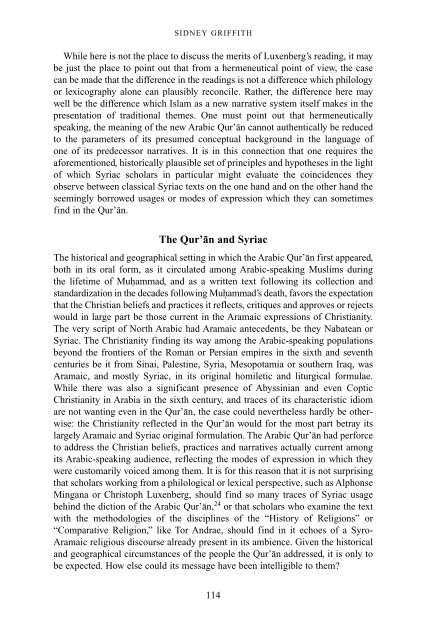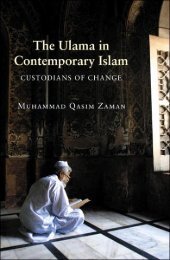The Qur'an in its historical context (pdf - Islam and Christian-Muslim ...
The Qur'an in its historical context (pdf - Islam and Christian-Muslim ...
The Qur'an in its historical context (pdf - Islam and Christian-Muslim ...
Create successful ePaper yourself
Turn your PDF publications into a flip-book with our unique Google optimized e-Paper software.
SIDNEY GRIFFITH<br />
While here is not the place to discuss the mer<strong>its</strong> of Luxenberg’s read<strong>in</strong>g, it may<br />
be just the place to po<strong>in</strong>t out that from a hermeneutical po<strong>in</strong>t of view, the case<br />
can be made that the difference <strong>in</strong> the read<strong>in</strong>gs is not a difference which philology<br />
or lexicography alone can plausibly reconcile. Rather, the difference here may<br />
well be the difference which <strong>Islam</strong> as a new narrative system <strong>its</strong>elf makes <strong>in</strong> the<br />
presentation of traditional themes. One must po<strong>in</strong>t out that hermeneutically<br />
speak<strong>in</strong>g, the mean<strong>in</strong>g of the new Arabic Qur’an cannot authentically be reduced<br />
to the parameters of <strong>its</strong> presumed conceptual background <strong>in</strong> the language of<br />
one of <strong>its</strong> predecessor narratives. It is <strong>in</strong> this connection that one requires the<br />
aforementioned, <strong>historical</strong>ly plausible set of pr<strong>in</strong>ciples <strong>and</strong> hypotheses <strong>in</strong> the light<br />
of which Syriac scholars <strong>in</strong> particular might evaluate the co<strong>in</strong>cidences they<br />
observe between classical Syriac texts on the one h<strong>and</strong> <strong>and</strong> on the other h<strong>and</strong> the<br />
seem<strong>in</strong>gly borrowed usages or modes of expression which they can sometimes<br />
f<strong>in</strong>d <strong>in</strong> the Qur’an.<br />
<strong>The</strong> Qur’an <strong>and</strong> Syriac<br />
<strong>The</strong> <strong>historical</strong> <strong>and</strong> geographical sett<strong>in</strong>g <strong>in</strong> which the Arabic Qur’an first appeared,<br />
both <strong>in</strong> <strong>its</strong> oral form, as it circulated among Arabic-speak<strong>in</strong>g <strong>Muslim</strong>s dur<strong>in</strong>g<br />
the lifetime of Muhammad, <strong>and</strong> as a written text follow<strong>in</strong>g <strong>its</strong> collection <strong>and</strong><br />
st<strong>and</strong>ardization <strong>in</strong> the decades follow<strong>in</strong>g Muhammad’s death, favors the expectation<br />
that the <strong>Christian</strong> beliefs <strong>and</strong> practices it reflects, critiques <strong>and</strong> approves or rejects<br />
would <strong>in</strong> large part be those current <strong>in</strong> the Aramaic expressions of <strong>Christian</strong>ity.<br />
<strong>The</strong> very script of North Arabic had Aramaic antecedents, be they Nabatean or<br />
Syriac. <strong>The</strong> <strong>Christian</strong>ity f<strong>in</strong>d<strong>in</strong>g <strong>its</strong> way among the Arabic-speak<strong>in</strong>g populations<br />
beyond the frontiers of the Roman or Persian empires <strong>in</strong> the sixth <strong>and</strong> seventh<br />
centuries be it from S<strong>in</strong>ai, Palest<strong>in</strong>e, Syria, Mesopotamia or southern Iraq, was<br />
Aramaic, <strong>and</strong> mostly Syriac, <strong>in</strong> <strong>its</strong> orig<strong>in</strong>al homiletic <strong>and</strong> liturgical formulae.<br />
While there was also a significant presence of Abyss<strong>in</strong>ian <strong>and</strong> even Coptic<br />
<strong>Christian</strong>ity <strong>in</strong> Arabia <strong>in</strong> the sixth century, <strong>and</strong> traces of <strong>its</strong> characteristic idiom<br />
are not want<strong>in</strong>g even <strong>in</strong> the Qur’an, the case could nevertheless hardly be otherwise:<br />
the <strong>Christian</strong>ity reflected <strong>in</strong> the Qur’an would for the most part betray <strong>its</strong><br />
largely Aramaic <strong>and</strong> Syriac orig<strong>in</strong>al formulation. <strong>The</strong> Arabic Qur’an had perforce<br />
to address the <strong>Christian</strong> beliefs, practices <strong>and</strong> narratives actually current among<br />
<strong>its</strong> Arabic-speak<strong>in</strong>g audience, reflect<strong>in</strong>g the modes of expression <strong>in</strong> which they<br />
were customarily voiced among them. It is for this reason that it is not surpris<strong>in</strong>g<br />
that scholars work<strong>in</strong>g from a philological or lexical perspective, such as Alphonse<br />
M<strong>in</strong>gana or Christoph Luxenberg, should f<strong>in</strong>d so many traces of Syriac usage<br />
beh<strong>in</strong>d the diction of the Arabic Qur’an, 24 or that scholars who exam<strong>in</strong>e the text<br />
with the methodologies of the discipl<strong>in</strong>es of the “History of Religions” or<br />
“Comparative Religion,” like Tor Andrae, should f<strong>in</strong>d <strong>in</strong> it echoes of a Syro-<br />
Aramaic religious discourse already present <strong>in</strong> <strong>its</strong> ambience. Given the <strong>historical</strong><br />
<strong>and</strong> geographical circumstances of the people the Qur’an addressed, it is only to<br />
be expected. How else could <strong>its</strong> message have been <strong>in</strong>telligible to them?<br />
114



